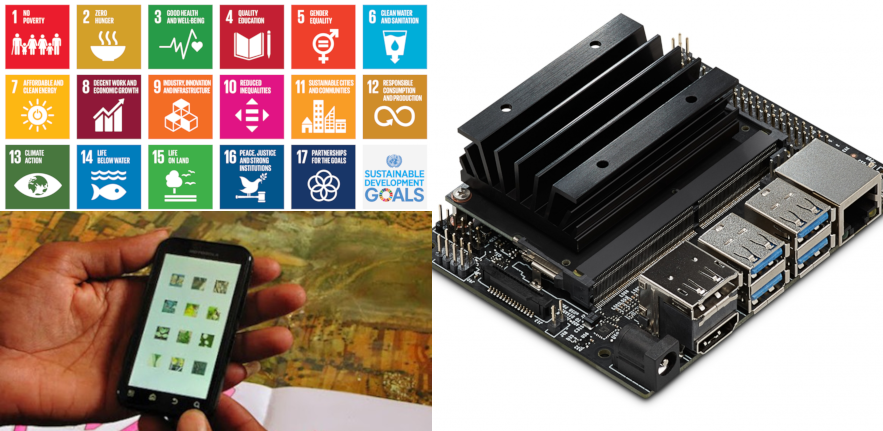
Smart imaging sandpit and seed funding
Calling Cambridge students and researchers across the arts, humanities and sciences subjects to develop smart imaging applications using low-cost, yet sophisticated computing and sensor hardware for applications in ODA-target countries
Two-day sandpit 26-27th November 2019
in Cambridge (location tbc)
Application deadline 3rd November 2019
Recent advances in low-cost computing hardware, sensor technology, and machine-learning tools have opened radical new opportunities for “Smart Imaging”. These disruptive technologies have the potential to transform health, environmental sustainability, food security, water and energy challenges faced in developing countries.
Applications
Apply by 3rd November 2019 here.
The programme will select an interdisciplinary group of 25 researchers from both STEM (Science, Technology, Engineering and Mathematics) and AHSS (Arts, Humanities and Social Sciences) disciplines which, together, can develop smart imaging solutions that are adequate to the developing world contexts that will be presented during the sandpit and that are responsive to the needs of communities that live in these contexts.
Please do not hesitate to contact Cambridge Global Challenges' Programme Manager (Sara Serradas Duarte, coordinator@gci.cam.ac.uk) if you would like to discuss your contribution to the programme of if you have any other questions.
Format
A two day-long sandpit for 25 participants will be followed by a seed-funding competition for the selection of 4 projects.

The programme and development of the projects will be informed by:
1) Direct understanding of challenges faced by communities in developing countries and design methodologies that equip the smart imaging-based approaches to respond to the needs of these communities
- Shorn Molokwane – Head of Design, Botswana Institute for Technology, Research Innovation: Shorn has been involved in the practice, teaching and research in design – aesthetics, social innovation, user-centered design, service design and fashion and textiles – for 25 years. He is currently leading the direction of design, development and production of products and services at Botswana Institute for Technology Research and Innovation (BITRI) –a parastatal research institute under the Ministry of Tertiary Education, Research, Science and Technology that identifies, develops and/or adapts appropriate technology solutions to provides sustainable innovative solutions through co-creation and collaboration in line with national priorities and needs of Botswana.With training in Design Thinking from Design Thinkers Academy (London) and MIT Sloan Executive Education, Shorn also runs transformation through Design Thinking. Shorn is an active member of the Design Thinkers Academy Network, and a regular collaborator at the Gaborone chapter of the Global Service Jam.
- John Stevens – Acting Director, Global Innovation Design Programme at the Royal College of Art): John joined the Royal College of Art in 2013 to help launch the new Global Innovation Design MA. John’s research interests concern the application of design methods to emerging contexts of innovation such as service design, multi-disciplinary design and design management, especially applied to social, cross-cultural and humanitarian innovation. This necessarily encompasses the design of products, interactions and systems.
2) Technical insight
- Marwa Mahmoud – Researcher in Computer vision, Machine learning and Human-computer interaction at the Department of Computer Science and Technology (University of Cambridge): Marwa works at the Graphics and Interaction group and teaches the assessment module for the MPhil Computer Vision course. Her research interests lie in the field of social signal processing and human behaviour understanding, which includes expressions of emotions or medical conditions. Marwa's research draws on computer vision, machine learning, Human Computer Interaction (HCI) and psychology, which makes it very exciting in its interdisciplinary aspects.
- James Allingham – Researcher in Machine learning Researcher at the Department of Engineering (University of Cambridge): James is a PhD candidate at the Machine Learning Group, where his primary research interests are in Bayesian deep learning and deep generative models. James is an organizer and Senior Tutor at Deep Learning Indaba, a programme that Strengthens African Machine Learning with the support of Google, Microsoft, IBM, Rockefeller Foundation, Facebook, Apple and others.
Overview of imaging-based approaches to challenges faced in ODA-target countries
Low-cost microscopy has been supporting the diagnosis and prevention of diseases in developing countries. 3D-printed microscopes can analyse body fluid samples and cameras compatible with widespread smartphones (smartphone owners in emerging and developing economies increased by 42% between 2014-2017) offer an alternative to conventional laboratory-based imaging equipment – with optometry being the most popular application to date. More recently, smartphone cameras have also been adapted to function as spectrometers. Recent advances in data-driven microscopy have also been enabling non-health professionals to use these low-cost imaging devices for the faster diagnosis and prevention of diseases, which are otherwise detected by specialists through time-consuming and error-prone blood cell and microorganism counts in blood and water samples. This is particularly relevant for diseases with highest incidence in developing regions such as malaria (half of the population is at risk and 93% of the 435,000 deaths occur in the African continent), HIV (25.6 million/69% patients in sub-Saharan Africa) and cholera (up to 143,000 deaths/year, two thirds of which in developing countries).
Biomedical imaging solutions are equally required in developing countries. Although 80-90% of their imaging needs can be met by radiography and ultrasound alone, two-thirds of the world’s population do not have access to radiography and 3-4 billion people are at the risk of death that can be avoided if radiology – required for most healthcare specialities including paediatrics, obstetrics and surgery – were available. Medical imaging devices (eg: radiography, functional near infrared spectroscopy, cardiovascular magnetic resonance and ultrasound) have been tailored to developing world contexts – through decreased dependency on external energy supply, increased portability, increased resistance to high temperature and humidity and application of low-cost sensors. Teleradiology solutions have also been developed for the sharing of medical images between health professionals for diagnosis at a distance. These biomedical imaging solutions have been coupled with data-driven techniques of higher performance in image reconstruction problems comparatively to traditional hand-crafted models. In line with these promising developments and as part of its most wide-ranging organisational reform, the WHO has recently announced the establishment of a new Department of Digital Health to maximise the opportunities offered by digital technologies and artificial intelligence and a New Division of Data, Analytics and Delivery to drive policy change.
The democratisation of Earth imaging enabled by the increasing number of launched satellite missions and the development of Unmanned Aerial Vehicles (UAVs) has also been improving disaster relief, the delivery of international development programmes and policy-making in developing countries. Issues related to environmental sustainability (under the strong demand of 97% of the world’s population growth in developing regions until 2030), food security (the vulnerability of crop production to climate change is higher in developing countries, due to their geographical location and lower infrastructure resilience), energy provision (it is predicted that more than half a billion people will remain without electricity in Sub-Saharan African by 2040) and urban planning (half of the African population will be urban by 2035) have been addressed. Indeed, imagery collected by satellites and UAVs can track changing levels of forest cover and biodiversity, define the effect of climate change in agriculture productivity, inform the selection appropriate sites in poor rural areas for the deployment of solar-powered microgrids and shape measures aiming to reduce road traffic fatalities in rapidly growing cities.
Finally, imagery collected on the ground can also inform traffic management measures aiming to decrease the high pollution levels in rapidly growing cities in developing countries (traffic cameras and smart phone-based optical devices recently developed to measure the density of aerosols in the atmosphere) and improve productivity and efficiency of animal farming (heat imaging).





